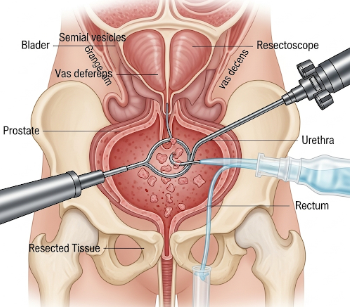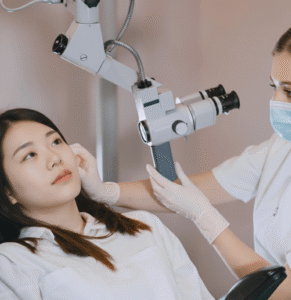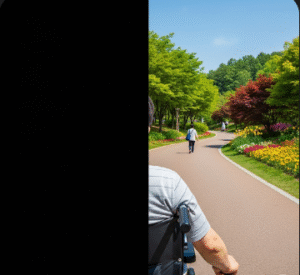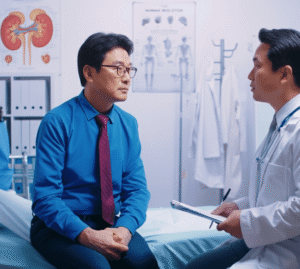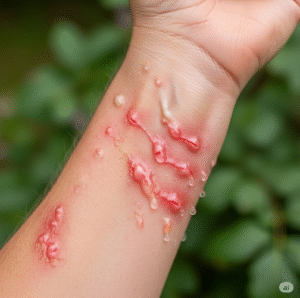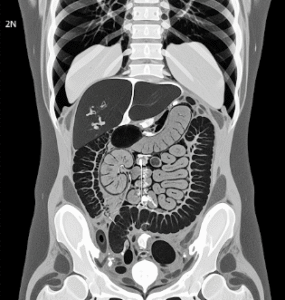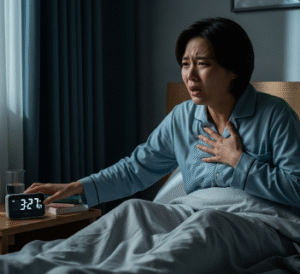What it is
Transurethral Resection of the Prostate (TURP) is a minimally invasive surgical procedure used to treat urinary problems caused by an enlarged prostate (benign prostatic hyperplasia, BPH).
➡ Key facts:
- ✔ Performed through the urethra using a resectoscope (no external incision required)
- ✔ Involves removing excess prostate tissue to improve urine flow
- ✔ Commonly used for men with moderate to severe BPH symptoms
- ✔ Widely available in urology departments of Korean hospitals and specialized surgical centers
💡 TURP is considered the gold standard for surgical management of BPH, balancing effectiveness with a minimally invasive approach.
Why it’s done
TURP is indicated when BPH causes significant urinary problems such as:
➤ Frequent urination, especially at night (nocturia)
➤ Difficulty starting urination or weak stream
➤ Incomplete bladder emptying → Risk of urinary tract infections or bladder stones
➤ Recurrent urinary retention → Emergency catheterization required
➤ Complications from BPH → Blood in urine, kidney damage, or bladder dysfunction
⚠ TURP is generally recommended after conservative treatments like medications have failed or if complications arise.
Alternatives / Complementary Measures
Other treatment options include:
✔ Medication therapy → Alpha-blockers (relax prostate muscles), 5-alpha-reductase inhibitors (shrink prostate)
✔ Minimally invasive procedures → UroLift, laser prostatectomy, or prostatic stents
✔ Lifestyle modifications → Reduce caffeine, manage fluid intake, bladder training
✔ Catheterization → Temporary relief for urinary retention
⚠ TURP is more effective for long-term relief of moderate to severe symptoms compared to medications alone.
Preparation
Before undergoing TURP in Korea:
🔹 Medical evaluation → Blood tests, urine tests, ECG, imaging (ultrasound)
🔹 Medication review → Stop blood-thinning medications as advised
🔹 Consent and counseling → Discuss procedure, risks, recovery, and potential complications
🔹 Bowel preparation → May be required prior to surgery
🔹 Fasting → Typically 6–8 hours before anesthesia
💡 Korean hospitals provide preoperative counseling, labs, and imaging to ensure patient safety and optimal outcomes.
How it’s done
➡ Step-by-step TURP procedure:
- Anesthesia → Spinal or general anesthesia
- Resectoscope insertion → Through the urethra to access the prostate
- Tissue removal → Excess prostate tissue is cut and cauterized to control bleeding
- Catheter placement → Temporary urinary catheter inserted for bladder drainage
- Monitoring → Patient monitored for bleeding, urine output, and vital signs
💡 In Korea, TURP is performed using modern endoscopic equipment, minimizing hospital stay and recovery time.
Effectiveness & Success Rate
✔ High success rate → 85–90% of patients experience improved urine flow
✔ Symptom relief → Reduces nocturia, urgency, weak stream, and urinary retention
✔ Durable results → Many patients remain symptom-free for 10–15 years
✔ Minimally invasive → Lower complication rates compared to open prostatectomy
💡 Korean urology centers integrate experienced surgeons, advanced endoscopes, and post-op care protocols for maximum effectiveness.
Recovery / Expected Outcomes
✔ Hospital stay → Usually 1–3 days depending on condition and age
✔ Catheter management → Catheter typically removed within 1–3 days post-surgery
✔ Urination → Initial burning or urgency may occur, improving over 1–2 weeks
✔ Activity → Light activities can resume within a few days; heavy lifting avoided for several weeks
✔ Follow-up → Routine monitoring of urine flow, PSA levels, and potential complications
💡 Most patients experience significant relief of urinary symptoms and improved quality of life.
Complications / Risks
⚠ TURP is generally safe but carries possible risks:
➡ Immediate complications:
- Bleeding or clot formation
- Urinary retention after catheter removal
- Infection
➡ Intermediate risks:
- Temporary urinary incontinence
- Urgency or frequency during recovery
- Erectile dysfunction or retrograde ejaculation (most common long-term side effect)
➡ Long-term considerations:
- Scar tissue may cause urethral stricture
- Repeat procedure required in rare cases (5–10%)
💡 Korean hospitals implement strict perioperative protocols and patient education to minimize risks.
Treatment Options in Korea (Post-TURP Care)
🔹 Hospital follow-up → Urine monitoring, catheter care, infection prevention
🔹 Medication support → Antibiotics or anti-inflammatory drugs if needed
🔹 Physical activity guidance → Avoid heavy lifting and strenuous activity
🔹 Lifestyle advice → Hydration, bladder training, dietary adjustments
🔹 Long-term monitoring → PSA testing, symptom tracking, and periodic checkups
💡 Korea emphasizes comprehensive post-operative care and patient education for optimal recovery.
Top Hospitals & Clinics in Korea for TURP
🏥 Seoul National University Hospital (SNUH) – Leading urology department with advanced TURP technology
🏥 Asan Medical Center (Seoul) – Expert surgeons and high-volume prostate surgeries
🏥 Samsung Medical Center (Seoul) – Specialized minimally invasive urology procedures
🏥 Yonsei Severance Hospital – Experience in managing elderly and high-risk patients
🏥 Regional tertiary hospitals – Access to TURP with endoscopic and laser alternatives
Conclusion
Transurethral Resection of the Prostate (TURP) in Korea is a highly effective, minimally invasive surgical procedure for treating urinary symptoms due to BPH.
✔ Provides long-term symptom relief and improved quality of life
✔ Safe and widely available in specialized urology centers
✔ Minimizes complications compared to traditional open surgery
✔ Korean hospitals ensure advanced surgical techniques, skilled surgeons, and comprehensive post-op care
By combining expert surgery, modern endoscopic tools, and attentive post-operative care, Korea ensures patients regain comfortable urination and enhanced daily functioning.

